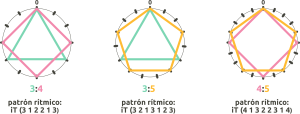Cyclic polyrhythmia
What is cyclic polyrhythmia?
It is the superposition of two or more rhythmic voices, defined by a fixed temporal interval (whose value remains the same during the whole cycle) and a fixed fraction. This generates two or more fixed velocities that coincide every so often, creating cycles. This cyclic relationship between rhythmic voices can be expressed by means of a ratio.
CYCLES IN EVERYDAY LIFE
 |
ciclo periódico   |
In our daily lives we are surrounded by cycles, by processes that begin, develop and end. Some of these cycles are periodic, such as the four seasons, which are repeated year after year, and others are not, such as getting a driver’s license. Likewise, polyrhythmic cycles may or may not be periodic.
 |
ciclo polirrítmico   |
The polyrhythmic cycle encompasses simultaneously the different voices of a cyclic polyrhythm. Within this cycle, there is a tension-distension movement between the pulses of the different voices: at the beginning of the cycle the pulses sound in unison, then they are out of phase due to the different velocities and at the end they are synchronized again coinciding with the end of the cycle and the beginning of the next one.
If we fusion the different voices, this offset and reunion of pulses generates a symmetrical succession of iT, which is a palindrome (i.e., it reads the same from left to right as from right to left, whether we go forward or backward in time). In this way, a curious effect of rhythmic elasticity is generated within the cycle. If we do it periodically, we generate a rhythmic pattern that feeds back with each repetition:

3:4   |
3:5   |
4:5   |

One of the voices always corresponds to the pulsations of the metronome, whether audible or not. We call it Voice 0 since it functions as a temporal reference for the rest of the voices. The values of its structure are predetermined: the fraction is 1/1 and the fixed iT is also 1.
THE RATIO OF THE POLYRHYTHMIC CYCLE
 |
ratio   |
A ratio is a proportion or relationship between two or more numbers. In the case of cyclic polyrhythmia, it represents the relationship between the number of iT in each voice, which coexist within the same cycle. In this way, the ratio will always contain as many numbers as voices we have overlaid.
We order these numbers always in the same way:
- In two-voice polyrhythmics, the first number of the ratio is equivalent to the number of iT of voice 1 and the second is equivalent to the length of the cycle (or number of pulsations of voice 0).
- In three-voice polyrhythms, the first number of the ratio is equivalent to the number of iT of voice 2, the second to the number of iT of voice 1, and the third to the length of the cycle (or number of pulsations of voice 0).
And so on, the last number always being the length of the cycle.
Below we share a collection of eleven basic ratios that can be used to start composing or studying two-voice polyrhythms. All of them are the result of combining two numbers between 2 and 7:
![]()


Each ratio can be read in two directions: from left to right and from right to left (for example the first one is 2:3 and also 3:2).

